





Do you have too many pears with a pantry already full of the same old canned preserves? Then try this easy no-fuss recipe that uses a lot of pears, produces two very useful treats with one effort, and make great gifts too. "No honeybees were harmed in making this honey!"
(Editor's Note: This article was originally published on November 3, 2010. Your comments are welcome, but please be aware that authors of previously published articles may not be able to respond to your questions or comments.)
A recipe for pear honey that was posted in the Dave's Garden Canning, Freezing, and Drying discussion forum (for subscribers), and friends with prolific pear trees, started an annual fall canning event for me. Many people contributed to the thread by posting comments about their positive experience with the recipe, along with tips and advice from similar recipes, and eventually a more no-fuss oven-roasted method developed.
The honey recipe yields an extra bonus treat of sugar-glazed pear pieces that are strained out of the finished product. When allowed to dry for a while, the fruit bits essentially became candied, or glace' (glazed) fruits, which are traditionally very time-consuming to make. The candied fruit can be eaten out of hand as a snack, or used in fruitcakes, cookies, muffins, and other desserts.
Any type of common pear, Pyrus communis, should work fine for the following recipes. I prefer the pears to be fully ripe, but they seem to make a darker honey and candy.
Here is an excerpt from the pear honey thread that includes the original recipe, if you would prefer it after reading the modified version.
Pear Honey
pears, pears and more pears... wonderful pear honey!, posted by lovesdaylilies, August 22, 2008
". . . this taste so much like honey its unreal.I found a couple pear syrup recipes that used no sugar. One was from France called Liege Syrup that cooked pear, or apple, juice in a copper kettle down to syrup, then sealed it into stoneware pots or glass jars. It was said to keep well for several years. [1]
The other recipe was from Germany called Pear Molasses. [1] The juice was extracted from 1-1/2 pounds of bruised pears and/or apples and allowed to simmer on the stove until the liquid thickened to the consistency of molasses, yielding approximately 1/2 cup. It is used as a spread on toast (like jelly), or to sweeten and add flavor to other goods. The recipe claimed the molasses would keep very well without further sterilization.
Mix ingredients together in a roasting pan and bake for 1 1/2 to 2 hours at 350 degrees F. Stir every 30 minutes until the pears start to become translucent and a golden to a golden-brown color. You want the liquid to be the color and consistency of actual honey, so you will need to test it frequently after the color starts changing. Drop a small portion onto a saucer, let it cool enough to taste and check the thickness and color.
Strain remaining pears out of the faux honey and set aside. Ladle the liquid into hot jars*, wipe jar rims, and seal with 2-part caps. Place jars into boiling water bath for 10 minutes.
The pear honey can be used as a sweetener in place of real honey, but has none of the medicinal qualities of actual bee honey, of course. I assume the jars require refrigeration after opening like jam or jelly.
* The number of jars will depend on how much your ingredients cook down, but usually a little less than half of what you started with. Alternatively, the cups of pears will equal the finished cups of honey, minus half a jar.
Because there was no waste with the little pear bits serving as candied delicacies, this made the pear honey recipe irresistible.
Take the pear bits strained from the pear honey and let them drain in a colander over a bowl or plate until no more syrup drips from them.
Place the fruit chunks onto drying racks with the dehydrator set on the highest temperature, or on cookie sheets in an oven set at the lowest temperature. A couple of dinner forks work well to separate the pieces.
Dry the pieces for a day, or until they reach a slight sticky feel, but are no longer wet. This may take a couple of days if the humidity is high. The sugary fruit will not reduce down in size like normally prepared fruit for drying.
Let the fruit candy cool to room temperature, then sprinkle generously with powdered sugar before or after removing from the drying racks or cookie sheets. Keep stirring and mixing until the pieces are no longer sticky, adding more powdered sugar as needed. Store candied fruit in airtight containers on the pantry shelf, or in the freezer for long-term storage.
Pears are closely related to apples, so many things that are done with apples can be done with pears. For instance, you can make pear cider that can be made into hard cider, which in turn can become pear vinegar. Pear vinegar can also be made using the cores (without the seeds) and peelings, a third treat from your effort, while utilizing nearly every scrap of the fruit that you harvested!
Sterilize a quart, or larger, glass jar and add enough fruit scraps to fill it 3/4 full. Add at least 1/2 cup of non-pasteurized apple cider vinegar (like Bragg's), or other vinegar containing a living "mother," to use as a starter. Pour enough distilled water into the jar to cover over the fruit. Secure a cotton cloth cover like, sackcloth, muslin, tea towel, or other, over the opening with a string or rubber band, to keep out bugs and dust while allowing the mix to breathe.
Store jar in a warm dark room for a couple of weeks, stirring every few days. After a few weeks, there should be a strong vinegary smell and you can strain and discard the fruit out of the liquid and bottle. Move vinegar to a cool dark room to finish mellowing for several months.
I am just now experimenting with the fascinating world of making vinegars myself, so I am waiting impatiently for the pear vinegar to mature. Until I can write about my vinegar ventures, here are a few pages to get more information:
Endnotes:
[1] The Gardeners and Farmers of Terre Vivante, Preserving Food Without Freezing or Canning (White River Junction, VT: Chelsea Green, 1999), Liege Syrup, 148.
[1] The Gardeners and Farmers of Terre Vivante, Preserving Food Without Freezing or Canning (White River Junction, VT: Chelsea Green, 1999), Pear Molasses, 145.
May your harvests be fruitful!
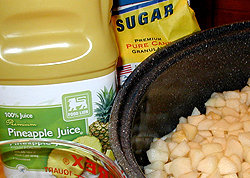
Ingredients for pear honey.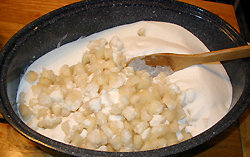
Mixing pears, pineapple juice & sugar. 
After 1 hour @ 350 degrees F oven.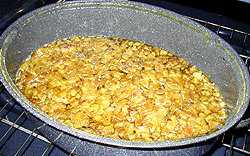
After 1-1/2 hours, syrup darkens quickly. 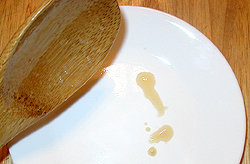
Cool a few drops to test consistency. 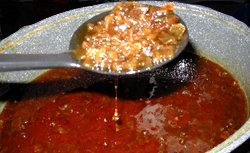
Strain out the pear parts. 
Can the pear honey. 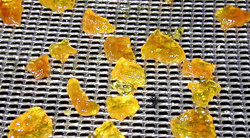
Pear pieces on a dehydrator rack. 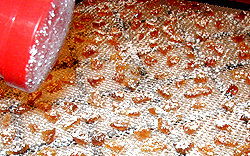
Shake powdered sugar over dried fruit. 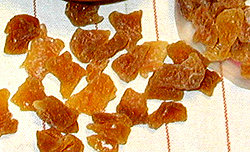
Finished candied, or glace', pears. 
Vinegar can be made from fruit scraps. 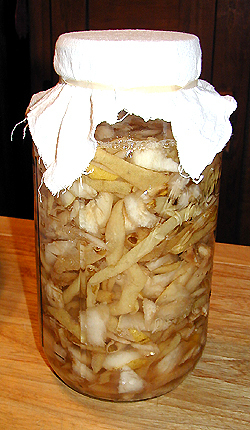
Brewing for pear vinegar.
Copyright © www.100flowers.win Botanic Garden All Rights Reserved